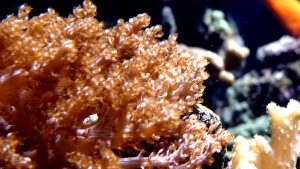This post may contain affiliate links. As an amazon associate I earn from qualifying purchase. Learn more
This post is about Kenya Tree Coral care.
Whether you are interested in keeping these corals or you just want to learn something new, you are in the right place.
In this guide, I will walk you through all the steps of taking care of Kenya Tree Coral, including its placement, lighting requirements and feeding schedule.
If you’ve ever wondered if there is a coral, that’s easy to care for, grows rapidly, practically a bullet-proof coral, then you’ve found it. It’s the Kenya Tree Coral.
Without further ado, let’s dive right into.

Contents
Kenya Tree Coral Care
The Kenya Tree Coral ( Capnella sp.) also known as the Broccoli Soft Coral and African Tree Coral is a popular soft coral in the aquarium hobby. It is mostly found in the Indo Pacific Ocean and the Red Sea, where it grows on reef slopes with strong currents.
You can see these types of corals as recommended on almost every beginner’s list. And there is a reason for that. They are easy to propagate, they don’t need expensive lighting and they can tolerate a wide range of conditions.
If you like to learn more about Kenya Tree Coral care keep reading.
Kenya Tree Coral Placement & Lighting
A good placement will benefit the coral itself. However, a bad placement not only will almost certainly prevent it from doing well but other corals in the tank as well.
In short, it’s imperative for you to find the perfect placement. I can’t stress the importance of this enough. What’s the best placement for Kenya Tree Coral, you may ask?
They are semi-aggressive corals, which means their aggression mainly depends on the conditions. How big is your tank? What other corals do you keep? How much space do you have between corals? And stuff like that.
Usually, soft corals such as Kenya Tree are aggressive towards hard corals. So be careful when you are mixing different types of corals in your reef tank.
However, there are a lot of different experiences and examples of keeping these corals. Some positive, some negative. Acclimate the coral properly, and start experiment with its placement.
One of the best things about soft corals is their low light requirement. That’s perfect for beginners and everyone else that doesn’t want to invest heavily in lights. Another thing that’s worth mentioning is the fact that they don’t do well under metal halides. Avoid that by placing them under rocks or other corals.
Kenya Tree Coral enjoy in turbid and strong water movement. However, moderate water flow is the best practice in home aquariums.
Kenya Tree Coral Feeding
Kenya Tree Coral, like any other coral, is a photosynthetic animal. It means that it relies on the zooxanthellae, symbiotic algae within the coral, to get most of its nutrients. However, there is something different about this particular coral. It’s not like the others.
In the wild, they primarily live in a nutrient-rich environment. That means they rely less on the light and more on the outside food to survive. Plankton and other dissolved materials are part of their diet.
In home aquariums, a proper lighting system will be sufficient to have success with these corals. In addition, the Kenya Tree Coral will absorb dissolved nutrients and microplankton from the water column. You can feed them similar foods if there is a deficiency in your tank.
Kenya Tree Coral Fragging
These corals grow and spread fast. And, when I say fast, I mean really fast. Some reef enthusiasts compare these corals with weed. Keep that in mind before you purchase a Kenya Tree Coral. It may sound good at first. And, sometimes it is. Every hobbyist likes to fill the tank as soon as possible, after all.
However, the truth is, that can cause you more problems then enjoyment down the road. But, for every problem, there is a solution. In this case? Fragging.
Kenya Tree corals are easy to propagate. If you want to keep them under control and believe me you do, frag them regularly. Just cut a part of the coral carefully, and then attach it to a frag plug or a rock surface. If you don’t want to have more of these corals in your tank, sell them to fellow hobbyists. Recently, I’ve seen more and more people give them away for free.
Conclusion
I hope this article not only answered the question: “How to take care of Kenya Tree coral”, but also helps you in the decision whether to buy it or not.
Now that you know all the pros and aware of the cons, I am confident that you will make the right decision.
Now, I am curious. Did your first experience with the Kenya Tree Coral was good or bad?
so far i like the kenya tree i see a part of laying on the gravel and like to put on a rock